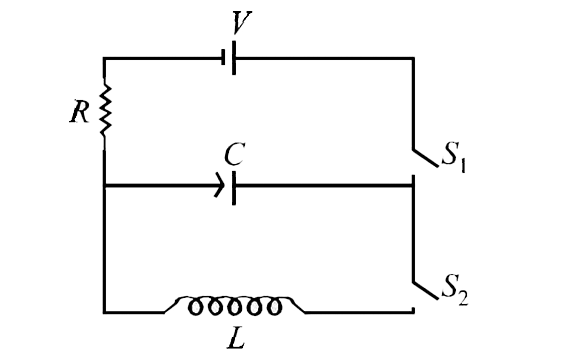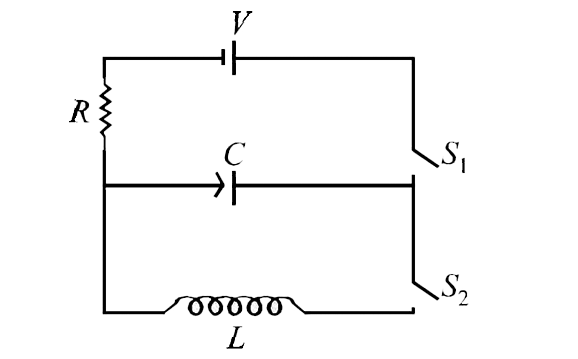Complete Solutions to Archives (linked Compreshension) of chapter INDUCTANCE of Class 12 book with complete answers and questions
| Class 12 | PHYSICS |
| Chapter | INDUCTANCE |
| CENGAGE PHYSICS | Archives (linked Compreshension) |
| Number Of Questions | 8 |
| Academic Year | 2023-24 |
In the given circuit the capacitor (C) may be charged through resistance R by a battery V by closing switch `(S_1)`. Also when `(S_1)` is opend and `(S_2)` is closed the capacitor is connected in series with inductor (L).

At the start, the capicitor was uncharged. when switch `(S_1)` is closed and `(S_2)` is kept open, the time constant of this circuit is `tau`. which of the following is correct
View SolutionIn the given circuit the capacitor (C) may be charged through resistance R by a battery V by closing switch `(S_1)`. Also when `(S_1)` is opend and `(S_2)` is closed the capacitor is connected in series with inductor (L).

When the capacitor gets charged compleely, (=`(S_1)` is opened and `(S_2)` is closed, Then,
View SolutionIn the given circuit the capacitor (C) may be charged through resistance R by a battery V by closing switch `(S_1)`. Also when `(S_1)` is opend and `(S_2)` is closed the capacitor is connected in series with inductor (L).

Given taht the total charge stored in the LC circuit is `(Q_0)`. for `Tge0, the charge on the capacitor is
View SolutionModern train are based on maglev technology in which trains are magntically levitated, which runs its `EDS` maglev system. There are coils on both sides of wheels. Due to motion of the train, current induces in the coil of track which levitate it. This is in accordance with Lenz's law. If train lowers down then due to Lenz's law, repulsive force increase due to which train gets uplifted and if it goes much higher then there is a net downward force due to gravity. The advantage of Maglev trains in that there is no friction between the train and the track, thereby reducting power consumption and enabling the train to attain very high speeds. Disavantage of Maglev train is that as it slows down, the electromagnetic forces decreases and it becomes difficult to keep it levitaited and as it moves forward according to Lenz's law there ia an electromagnetic drag force.
What is the advantage of this system?
View SolutionModern train are based on maglev technology in which trains are magntically levitated, which runs its `EDS` maglev system. There are coils on both sides of wheels. Due to motion of the train, current induces in the coil of track which levitate it. This is in accordance with Lenz's law. If train lowers down then due to Lenz's law, repulsive force increase due to which train gets uplifted and if it goes much higher then there is a net downward force due to gravity. The advantage of Maglev trains in that there is no friction between the train and the track, thereby reducting power consumption and enabling the train to attain very high speeds. Disavantage of Maglev train is that as it slows down, the electromagnetic forces decreases and it becomes difficult to keep it levitaited and as it moves forward according to Lenz's law there ia an electromagnetic drag force.
What is the disadvantage of this system?
View SolutionModern train are based on maglev technology in which trains are magntically levitated, which runs its `EDS` maglev system. There are coils on both sides of wheels. Due to motion of the train, current induces in the coil of track which levitate it. This is in accordance with Lenz's law. If train lowers down then due to Lenz's law, repulsive force increase due to which train gets uplifted and if it goes much higher then there is a net downward force due to gravity. The advantage of Maglev trains in that there is no friction between the train and the track, thereby reducting power consumption and enabling the train to attain very high speeds. Disavantage of Maglev train is that as it slows down, the electromagnetic forces decreases and it becomes difficult to keep it levitaited and as it moves forward according to Lenz's law there ia an electromagnetic drag force.
Which force causes the train to elevate up?
View SolutionA point charges Q is moving in a circular orbit of radius R in the x-y plane with an angular velocity `omega`. This can be considered as equivalent to a loop carrying a steady current `(Q omega)/(2 pi)`. S uniform magnetic field along the positive z-axis is now switched on, which increases at a constant rate from 0 to B in one second. Assume that the radius of hte orbit remains constant. The application of hte magnetic field induces an emf in the orbit. The induced emf is defined as the work done by an induced electric field in moving a unit positive charge around a closed loop. It si known that, for an orbiting charge, the magnetic dipole moment is proportional to the angular momentum with a porportionality constant `lambda`.
The magnitude of the induced electric field in the orbit at any instant of time during the time interval of the mangnetic field change is
View SolutionA point charges Q is moving in a circular orbit of radius R in the x-y plane with an angular velocity `omega`. This can be considered as equivalent to a loop carrying a steady current `(Q omega)/(2 pi)`. S uniform magnetic field along the positive z-axis is now switched on, which increases at a constant rate from 0 to B in one second. Assume that the radius of the orbit remains constant. The application of the magnetic field induces an `EMF` in the orbit. The induced `EMF` is defined as the work done by an induced electric field in moving a unit positive charge around a closed loop. It is known that, for an orbiting charge, the magnetic dipole moment is proportional to the angular momentum with a proportionality constant `lambda`. The charge in the magnetic dipole moment associated with the orbit, at the end of the time interval of the magnetic field charge, is
View Solution
Archives (linked Compreshension) questions and complete solutions for chapter INDUCTANCE of CENGAGE PHYSICS (ENGLISH) of Class 12
All Exercises from CENGAGE PHYSICS Class 12 PHYSICS INDUCTANCE
- Archives (fills In The Blanks)
- Archives (integer)
- Archives (linked Compreshension)
- Archives (multiple Correct)
- Archives (single Correct )
- Comprehension Type
- Concept Based
- Exercise 4.1
- Exercises (assertion-reasoning)
- Exercises (integer)
- Exercises (linked Compreshension)
- Exercises (multiple Correct )
- Exercises (single Correct )
- Exercises (subjective)
- Illustration
- Multiple Correct Answer
- Single correct Answer Type
- Solved Examples
- Subective Type